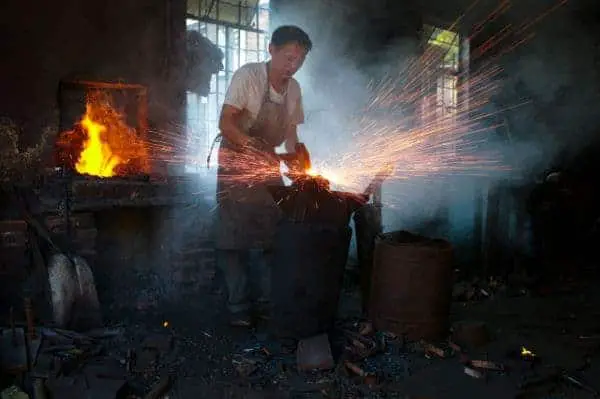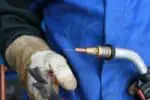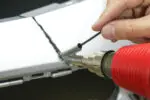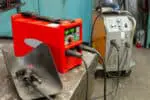Forging can be traced historically to at least 4,000 BC for the making of tools and weapons. What kind of forge you use when blacksmithing will probably be your most important decision among several you’ll need to make.
 There are basically two types of forges used regularly today: coal or gas. If you are a beginner, a gas forge will probably be a cleaner and safer type to start your projects.
There are basically two types of forges used regularly today: coal or gas. If you are a beginner, a gas forge will probably be a cleaner and safer type to start your projects.
If you have organized a nice area in your garage or workshop, you’ll know that forging can be quite intrusive to neighbors if you are using coal and there is thick black smoke pouring out, even if from a chimney.
Propane forge can eliminate this problem and keep you out of trouble in your neighborhood. Let’s consider coal vs. gas forging.
| Product | Burners | Insulation | Temperature Max | Weight |
|---|---|---|---|---|
| Cast Master Elite CMF 2000 Double Burner Portable Forge | Two | 1.5-inch Kaowool fire blanket, 2 fire bricks | 2433°F | 36 lbs. |
| Hell’s Forge Propane Portable Forge | One | One-inch ceramic fiber cover, fire brick, Hellcote Refractory Material | 2300°F | 23 lbs. |
| Hell’s Forge Propane MAX Double Burner | Two | one-inch ceramic fiber cover, 2 fire bricks, Hellcote 3000 Refractory Coating | 2300°F | 29 lbs. |
| Hell’s Forge Propane Double Burner Forge Large Capacity | Two | one-inch ceramic fiber cover, 2 fire bricks, Hellcote 3000 Refractory Coating | 2300°F | 25 lbs. |
| Simond Store Single Burner Propane Forge | One | one-inch ceramic fiber blanket, fire brick | 2600°F | 24.5 lbs. |
Our Best Propane Forge Choices
Overall Best Propane Gas Forge
1. Cast Master Elite CMF 2000 Double Burner Portable Forge
- KEEP BLACKSMITHING FUN! With a high temperature topping two thousand degrees Fahrenheit .
- PACKED WITH FEATURES We include everything you’ll need to connect your propane tank to the forge.
- TAKE YOUR PROJECTS FARTHER, FASTER Quickly reaching and maintaining optimum temperature is the gold standard of forges and furnaces.
- EASY TO FOLLOW DIRECTIONS We include a thorough set of paper directions.
- US-BASED CUSTOMER SUPPORT Our mission is to ensure you’re absolutely pleased with your Cast Master product .
Prices pulled from the Amazon Product Advertising API on:
Product prices and availability are accurate as of the date/time indicated and are subject to change. Any price and availability information displayed on [relevant Amazon Site(s), as applicable] at the time of purchase will apply to the purchase of this product.
This is the most recent addition as well as the largest of the Cast Master forges. An exceptional oval shaped forge, this includes double burners to reach a temperature of 2433°F meaning you can work with just about any metal.
Made in the USA, the bottom hosts two fire bricks, while insulation is guaranteed by a 1.5-inch Kaowool fire blanket to ensure even heating.
Pros:
-
-
-
- Good for large projects
- Reaches a high temperature
- Exceptional construction
- Kaowool insulation and 2 fire bricks
-
-
Cons:
-
-
-
- No refractory coating
-
-
The Best Knifemaking propane Forge
2. Hell’s Forge Propane Portable Forge
- Single forge burner furnace with 2300+F capacity- perfect for smaller projects.
- Includes container of HELLCOAT 3000 Refractory Coating .
- Unique oval design allows for ideal exposure to the flames sweet spot.
- 1 high density rigid coated for extended life ceramic fiber blanket.
- Includes full size thick fire brick (4.5 X 9 X 1.25) for the bottom.
Prices pulled from the Amazon Product Advertising API on:
Product prices and availability are accurate as of the date/time indicated and are subject to change. Any price and availability information displayed on [relevant Amazon Site(s), as applicable] at the time of purchase will apply to the purchase of this product.
This is an appealing forge for blacksmiths that require a smallish propane forge. It features an 1/8-inch steel body and in spite of its compact design is pretty roomy with 3.5 foot x 3/4 inch x 10 inch space.
Although it only uses a single burner, it can reach 2000° F. relatively quickly and can go as high as 2300°F. This forge comes with an adjustable choke for fire control. The shape is oval and comes with Hellcote Refractory Material to ensure heat retention and durability.
The insulation is a one-inch ceramic fiber cover that protects from extreme temperatures and the ceramic paint weathers 2000° F temperatures without difficulty.
The bottom hosts a fire brick that is 10 inches long and just short of 9 inches wide that guarantees a solid base. Affordable, it does not require complicated hook ups or a chimney. Just connect the gas source to the burner and you are good to go!
Pros:
-
-
-
- Ready for use
- Solid design and construction
- Regular Maintenance not necessary
-
-
Cons:
-
-
-
- Ideal only to smaller metal
- Can be noisy
- Will produce carbon monoxide without ventilation
-
-
The Best Pressure Regulating Forge
3. Hell’s Forge Propane MAX Double Burner
- USA MADE double forge burner furnace with 2300F capability and UPGRADED 0-30 psi regulator.
- Large size (6 x 4.75 x 19) provides max workspace, ideal exposure to the flames sweet spot.
- 1 thick ceramic fiber blanket ships with HELLCOTE 3000 Refractory Coating.
- Solid Stainless Steel burner assembly and Includes 2 full size, thick (9 x 4.5 x 1.25) fire bricks.
- We beat the competition with 5 X’s THICKER STEEL than competitor’s imported thin sheet metal version.
Prices pulled from the Amazon Product Advertising API on:
Product prices and availability are accurate as of the date/time indicated and are subject to change. Any price and availability information displayed on [relevant Amazon Site(s), as applicable] at the time of purchase will apply to the purchase of this product.
This is a double burner forge that boasts a generous fire bed that heats evenly. The body is manufactured in stainless steel. Burners use Venturi technology to produce a blue flame for speedy heating.
As with other forges of this brand it comes with Hellcote 3000 refractory coating to increase durability of the ceramic fiber insulation. This combo works to ensure better retention of heat, good heat reflection and protect you from toxic fumes
The design is square with two burners that are vertically mounted. You can choose to use an individual burner as opposed to two, but you’ll need more time to reach 2300°F.
Construction is robust at 11-gauge and 0.13-inch thickness. The surprise? It weighs in at only 29 lbs. and comes with a handle for easy moving.
The flame temperature is adjustable thanks to a 30 PSI regulator of pressure and a 48-inch hose. The package comes complete with a forge, the pressure regulator, 2 burners refractory coating, two fire bricks and a 3/8inch flare adapter.
Pros:
-
-
-
- No coal dust or clinker
- Easy to clean and operate
- Reaches 2300° F. speedily
-
-
Cons:
-
-
-
-
- Noisy
- Radiates a lot of heat
- Will produce carbon monoxide without ventilation
-
-
-
The Best Large Capacity Forge
4. Hell’s Forge Propane Double Burner Forge Large Capacity
- Double forge burner furnace with 2300+F capability and perfect for larger projects.
- Large (19 x 6.75 x 3.5) oval design allows for maximum workspace and ideal exposure to the flames sweet spot.
- Includes container of HELLCOAT 3000 Refractory Coating .
- 1 high density rigid coated extended life ceramic fiber blanket.
- Includes two full size, thick (9 x 4.5 x 1.25) fire bricks for the bottom.
Prices pulled from the Amazon Product Advertising API on:
Product prices and availability are accurate as of the date/time indicated and are subject to change. Any price and availability information displayed on [relevant Amazon Site(s), as applicable] at the time of purchase will apply to the purchase of this product.
This is a large capacity forge, that nonetheless, is lightweight. Featuring two burners that are vertically mounted, heating is even and quick. If you need to work at a lower temperature, you can use only one of the two burners.
Thanks to 180,000 heat BTUs you will reach the maximum temperature in a matter of minutes. The oval design is open ended allowing for work on both smaller and larger projects.
Ceramic blanket insulation measures one inch thick and will conserve the heat because of the Hellcote 3000 refractory coating provided with the forge.
Lightweight at 22.1 lbs., it’s portable and features a handle that doesn’t heat up for easy movement. A fire brick can be used to close the open end if necessary, for improved heat retention.
This forge comes with a regulator for high pressure (20 PSI) and a flare adaptor that is 3/8-inch. The hose is 48 inches. And two full-sized bricks are included.
Pros:
-
-
-
- Affordable
- Easy operation
- Achieve a high temperature quickly
-
-
Cons:
-
-
-
- High consumption of fuel
- Cannot heat large pieces of metal
-
-
The Best Lightweight Forge
5. Simond Store Single Burner Propane Forge
- Single Burner Propane Forge Furnace with 2600 degree capacity.
- lined by 1 thick high density ceramic fiber blanket.
- Comparatively High Tensile Strength & Can withstand Direct Flame.
- Comes with stand.
- Our gas pressure regulator connection fit for these countries: UNITED STATES, CANADA, AUSTRALIA, NORWAY, SWEDEN, NEW ZEALAND, FINLAND, and ISRAEL.
Prices pulled from the Amazon Product Advertising API on:
Product prices and availability are accurate as of the date/time indicated and are subject to change. Any price and availability information displayed on [relevant Amazon Site(s), as applicable] at the time of purchase will apply to the purchase of this product.
Affordable, efficient and lightweight can best describe this single burner forge. This is a great choice for blacksmiths, jewelers or bladesmiths. Weighing 24.6 lbs., it is portable. The burner is manufactured in Grade SS-304 steel for durability.
If you need to twist or bend small pieces, this is the forge for you. The forge is insulated with ceramic wool. A high-pressure nozzle together with the choke guarantee a neutral flame. This forge also includes a stand for your pair of tongs.
Pros:
-
-
-
- Temperature up to 2600°F
- Budget-friendly
- Stand for tongs
-
-
Cons:
-
-
-
- Single burner may need more time for heating
-
-
What is a Gas Forge?
This is a forge that will use either propane or natural gas as fuel. Gas forgers are recent inventions as historically blacksmiths did not enjoy this option. These forges do bring some benefits:
-
-
-
- Easy to use thanks to a dial control that starts the heating up.
- Temperature Control is easier and more precise.
- Much cleaner without the dirt, dust and smoke produced by coal.
- No need to dedicate constant attention to maintain the fire.
-
-
There are also a couple of disadvantages:
-
-
-
- Size. They tend to be smaller in size, so if you have a big project, keep this in mind.
- Temperature. While they do reach high temperatures, a lot will depend on what you are forging. Most gas forges are more than adequate for steel but may struggle if you want to forge iron.
-
-
Gas Forge or Coal Forge?
If you are a beginner blacksmith, gas is probably a better choice. One of the difficulties with a coal forge is the amount of heat it produces. It can become so hot, that it turns molten.
It will then probably produce a waste material. Before you know it, the formation of clinker leaves you with a mess to deal with.
A Gas forge is not only much cleaner, it’s also very easy to ignite. It will not contaminate your work, which coal could and might do. The great thing about a gas forge is that you will not be dirty and covered in coal dust at the end of your project, and you won’t be inhaling coal dust that can affect your health. Gas is definitely a cleaner option for your workshop and can be for your overall well-being.

You can also do several pieces at a time without worrying about overheating or burning thanks to presetting the heat at the start. However, the dealbreaker may be what type of metal you plan to forge. If it’s iron, a propane forge may not be the correct option. Also, gas forges do require proper ventilation for safety purposes.
The coal forge may be preferred by professional blacksmiths or those who already have acquired a great deal of experience in forging. They are better equipped to forge iron because they can reach higher temperatures.
There is a third type of forge that is rarely referred to nowadays: the wooden forge. Historically these were used by blacksmiths for tempering metal. The advantage in the past was that firewood was easy to find as opposed to coal and was less expensive if not free.
Now, because of technology, these forges are no longer really used.
What to consider when selecting a propane forge
As there are many choices available on the marketplace, you will need to consider what your necessities are when selecting. Here are some factors that are important when purchasing your propane forge.
1.) Size and Shape
Gas forges are available in various shapes and all sizes. No shape or size is specifically better than another. The shape will depend a bit on what you intend to forge.
If you want to forge a sword, one of the longer cylinder-shaped forges might be more convenient. If you will be doing small projects, you can select a smaller one.
So, the most important consideration here is what type of object you intend to forge. If your project is big or oddly shaped, keep this in mind when choosing your forge and portable is a plus.
2.) The Burner
There are basically two kinds of burners used: an air forced burner or a Venturi burner. The air forced burner will be a bit more difficult to work with and also a bit less secure.
If you are a beginner, the Venturi will probably be a better selection. They are easily operated and quite safe and secure. They also will probably cost a bit less.
Often DIYers might use a double burner for gas. However, if you only need a single burner for your projects, go ahead and just choose the single gas burner.
The burner regulator should preferably be a double gauge that indicates both inlet pressure and outlet pressure.
3.) Insulation
Insulation is crucial. There are three types of insulation most commonly used:
Insulating fibers. These are the fibers often used in house insulation. They are similar to wool in texture. Fiber is particularly indicated for cylinder-shaped forges because it can take the shape of the forge.
It’s versatile and light, long-lasting, and provides great insulation. It also doesn’t remove heat from the forge, allowing it to heat up quickly.
Fire Brick. This type of insulation comes with a couple of choices. It can be either hard or soft. The softer fire brick is better for insulation. This type of insulation is great for box-shaped forges or for the bottoms of forges.
It is sold in thinner slabs or in the form of bricks that are relatively thick. This type of bottom insulation can be removed without disturbing the walls of your forge.
Castable Refractories. These are similar to concrete or Portland cement. It is very adaptable to higher temperatures. You just mix it and create the mold.
Once it sets, you have a refectory insulator. They do absorb more heat than the other types which means slower heating and perhaps a bit less efficiency, however, they are big on durability.
4.) Durability. Since you won’t be buying a forge every week, look for one constructed with at least 11” gauge steel. Steel that is low quality may deform at high temperatures.
5.) Cost. Your budget is always a factor. Just because it is expensive doesn’t make it the best, just as the cheapest will not necessarily be the worst. The product you select should offer value for your money.
FAQ
Do I need a forge?
If you want to reshape or temper metal, yes. Blacksmithing does not exist without a forge.
What’s the best forge in a neighborhood context where people are in the vicinity?
If you are sensitive to environmental issues and worried about the well-being of neighbors, you will want to avoid a fossil fuel like coal. In this case, a propane gas forge is your best bet because it pollutes much less.
Does my gas forge need a blower?
Not necessarily. Many forges work with the Venturi burner. By rotating the choke, you can adjust the oxygen/propane ratio.
Will my gas forge need a chimney?
No. A gas forge does not require a chimney or even a hood unless your local codes say otherwise. A gas forge can also be used indoors if it works properly. If you do use it indoors, keep a low oxygen or carbon monoxide sensor inside to protect yourself and anyone else in the room from toxic gases.
Does a propane gas forge require much maintenance?
No. It requires much less maintenance and cleaning than a coal forge. An added plus is that it will also heat up your workshop nicely during colder seasons.
Is it possible to propane forge using lower pressure?
Some forges are designed to run on lower pressure.
Is a propane gas forge portable?
Yes, numerous models are portable.
How long will a propane forge last when using it?
A 20lb. tank will probably manage seven hours and perhaps a bit longer. If you have a bigger tank, it will last longer.
Is propane forging safe?
As in all blacksmithing, safety is the basis for success. Regardless of the type of forge you use, you must exercise caution. Any type of carelessness will lead to accidents and in a worst-case scenario, you may have a major fire break out.
Maintenance Tips
-
-
- Check all working parts such as valves, gauges and regulators, at regular intervals for normal wear and tear.
-
-
-
- Always replace or repair any damaged part immediately for your safety.
-
-
-
- If the inner insulation lining is less than one inch, replace it.
-
-
-
- Only use manufacturer approved replacement parts.
-
-
-
- Check for gas leakage at every use.
-
-
-
- Keep the forge away from water and excessive humidity or moisture.
-
-
-
- Avoid accumulation of dirt or dust.
-
The Bottom Line
If you’re looking for a budget option, consider the Single burner forge manufactured by Simond Store.
Our overall choice is the Cast Master Elite CMF 2000 Double Burner Portable Forge, however any of these forges merit consideration. Happy blacksmithing!











